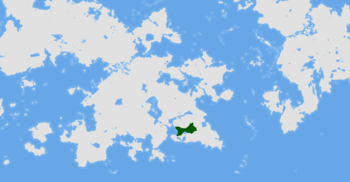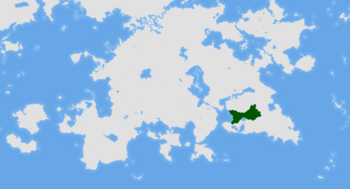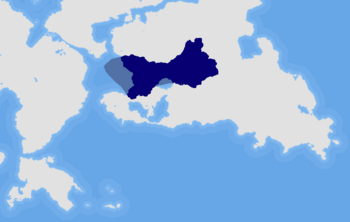Federation of Yugoslavia: Difference between revisions
Yugoslavia (talk | contribs) No edit summary |
Yugoslavia (talk | contribs) No edit summary |
||
| Line 53: | Line 53: | ||
|area_km2 = 486,255.971 | |area_km2 = 486,255.971 | ||
|area_label = Total | |area_label = Total | ||
|population_estimate = | |population_estimate = 84,833,022 | ||
|population_estimate_year = | |population_estimate_year = 2022 | ||
|population_census = | |population_census = 83,772,916 | ||
|population_census_year = | |population_census_year = August 2019 | ||
|population_density_km2 = | |population_density_km2 = 172.28 | ||
|GDP_PPP = 3, | |GDP_PPP = $3,828 trillion | ||
|GDP_PPP_rank = | |GDP_PPP_rank = | ||
|GDP_PPP_year = | |GDP_PPP_year = 2022 | ||
|GDP_PPP_per_capita = | |GDP_PPP_per_capita = $45 695 | ||
|GDP_PPP_per_capita_rank = | |GDP_PPP_per_capita_rank = | ||
|GDP_nominal = | |GDP_nominal = $2,711 trillion | ||
|GDP_nominal_year = | |GDP_nominal_year = 2022 | ||
|GDP_nominal_per_capita = | |GDP_nominal_per_capita = $32 381 | ||
|Gini = | |Gini = 28.3 | ||
|Gini_change = decrease | |Gini_change = decrease | ||
|Gini_year = | |Gini_year = 2019 | ||
|HDI = 0. | |HDI = 0.878 | ||
|HDI_change = increase | |HDI_change = increase | ||
|HDI_year = 2018 | |HDI_year = 2018 | ||
|currency = | |currency = Yugoslav dinar (đ)<br> | ||
1 | 1đ:1.17€ | ||
|time_zone = UTC 0 | |time_zone = UTC 0 | ||
|utc_offset = | |utc_offset = | ||
|date_format = dd | |date_format = dd. mm. yyyy. | ||
|drives_on = right | |drives_on = right | ||
|cctld = . | |cctld = .yu | ||
|iso3166code = | |iso3166code = YU | ||
|calling_code = [[+ | |calling_code = [[+38]] | ||
}} | }} | ||
The '''Federation of Yugoslavia''', officially the '''Royal State of the Federation of Yugoslavia''' ([[Chernogorkan]]: ''Koroljevska Deržava Federacije Jugoslavije'', Королйевска Держава Федерацийе Йугославийе; known informally as '''Yugoslavia''') is a country located in the Southeastern [[Thrismari]]. It is surrounded by [[Lindstaten]] to the north, [[Wassilia]] to the east, [[Sacrofnia]] and the [[Kolpa Lake]] to the south, and the [[Kaldaz Ocean]] shoreline to the west. It's three federated units, ''krajine/крайине'', and the [[Chernograd Capital District|capital district]] comprise a total area of 486,255.971 km<sup>2</sup> (187,744.48 square miles), on which reside 83,772,916 residents (2019 Census), corresponding to 172.28 per km<sup>2</sup> (446.21 per sq mi). Yugoslavia is a parliamentary democracy under a constitutional monarchy, ruled by king [[King Paul I of Yugoslavia|Paul I]] of the [[House of Karažev]] since 1992. The federal capital is [[Chernograd Capital District|Chernograd]] (Chernogorkan: ''Černograd'', Черноград; lit. ''black city''), a city of more than 8 million people situated on the shores of Kolpa Lake; the city is the financial, industrial, and scientific centre of Yugoslavia, hosting the [[Royal Institute of Science]] and the [[University of Chernograd]]. The entire nation is mostly flat in the interior; the littoral region is moderately hilly and uneven, while the eastern borderlands with Wassilia are composed of mostly low summits and peaks of the [[Trizub Range|Trizub mountain range]]. The highest summit is in the northeasternmost corner of the country, [[Sventovid Peak]], measuring at 2,063 metres above sea level. | The '''Federation of Yugoslavia''', officially the '''Royal State of the Federation of Yugoslavia''' ([[Chernogorkan]]: ''Koroljevska Deržava Federacije Jugoslavije'', Королйевска Держава Федерацийе Йугославийе; known informally as '''Yugoslavia''') is a country located in the Southeastern [[Thrismari]]. It is surrounded by [[Lindstaten]] to the north, [[Wassilia]] to the east, [[Sacrofnia]] and the [[Kolpa Lake]] to the south, and the [[Kaldaz Ocean]] shoreline to the west. It's three federated units, ''krajine/крайине'', and the [[Chernograd Capital District|capital district]] comprise a total area of 486,255.971 km<sup>2</sup> (187,744.48 square miles), on which reside 83,772,916 residents (2019 Census), corresponding to 172.28 per km<sup>2</sup> (446.21 per sq mi). Yugoslavia is a parliamentary democracy under a constitutional monarchy, ruled by king [[King Paul I of Yugoslavia|Paul I]] of the [[House of Karažev]] since 1992. The federal capital is [[Chernograd Capital District|Chernograd]] (Chernogorkan: ''Černograd'', Черноград; lit. ''black city''), a city of more than 8 million people situated on the shores of Kolpa Lake; the city is the financial, industrial, and scientific centre of Yugoslavia, hosting the [[Royal Institute of Science]] and the [[University of Chernograd]]. The entire nation is mostly flat in the interior; the littoral region is moderately hilly and uneven, while the eastern borderlands with Wassilia are composed of mostly low summits and peaks of the [[Trizub Range|Trizub mountain range]]. The highest summit is in the northeasternmost corner of the country, [[Sventovid Peak]], measuring at 2,063 metres above sea level. | ||
The first traces of human activity in the lands of contemporary | The first traces of human activity in the lands of contemporary Yugoslavia are about 1.1 million years old. About 350,000 years ago, there are traces of Neanderthal presence in Yugoslavia, located in [[Velika Plana cave]] of the Trizub mountain range. Cro-magnons appeared some 40,000 years ago, but have left no significant traces of their presence, possibly because the ''Homo sapiens'' arrived approximately 10,000 years later and became the dominant variant of modern humans. Neolithic era brought about [[Halka culture]] around the Kolpa lake, and [[Janski culture]] in the littoral region. | ||
Revision as of 23:47, 21 November 2023
Royal State of the Federation of Yugoslavia Koroljevska Deržava Federacije Jugoslavije (Chernogorkan)
Королйевска Держава Федерацийе Йугославийе (Cyrillic) | |
|---|---|
Motto: Jeden narod, jeden korolj, jedna deržava "One people, one king, one state" | |
Anthem: "Hej Slaveni!" "Hey Slavs!" | |
Location of Yugoslavia (blue or dark green) | |
| Capital and largest city | Chernograd |
| Official languages | Chernogorkan |
| Recognised national languages | Chernogorkan, Cordomonivence Slavonic |
| Ethnic groups (2019) | Chernozemci (43%) Gorkanki (31%) Storonci (11%) Morrawian (9%) Other (6%) |
| Demonym(s) | Yugoslav |
| Government | Parliamentary democracy under a constitutional monarchy |
• King of Yugoslavia | Paul I |
• Prime Minister | Nikolaj Novosel |
| Legislature | The Federal Assembly of Yugoslavia |
| The Royal Council | |
| The House of Peoples | |
| Establishment | |
• Arrival of the Slavs | 6th century |
• Duchy of Gorka | 10th century |
• Great Peasant Rising | 1493 |
• Kingdom of Gorka | 1711 |
• Kingdom of Chernogorka | 2nd February 1848 |
• Unification referendum | 18th November 1953 |
• Federation of Yugoslavia | 14th January 1955 |
• Coronation of Paul I | 1st December 1992 |
| Area | |
• Total | 486,255.971 km2 (187,744.480 sq mi) |
| Population | |
• 2022 estimate | 84,833,022 |
• August 2019 census | 83,772,916 |
• Density | 172.28/km2 (446.2/sq mi) |
| GDP (PPP) | 2022 estimate |
• Total | $3,828 trillion |
• Per capita | $45 695 |
| GDP (nominal) | 2022 estimate |
• Total | $2,711 trillion |
• Per capita | $32 381 |
| Gini (2019) | low |
| HDI (2018) | very high |
| Currency | Yugoslav dinar (đ) 1đ:1.17€ |
| Time zone | UTC 0 |
| Date format | dd. mm. yyyy. |
| Driving side | right |
| Calling code | +38 |
| Internet TLD | .yu |
The Federation of Yugoslavia, officially the Royal State of the Federation of Yugoslavia (Chernogorkan: Koroljevska Deržava Federacije Jugoslavije, Королйевска Держава Федерацийе Йугославийе; known informally as Yugoslavia) is a country located in the Southeastern Thrismari. It is surrounded by Lindstaten to the north, Wassilia to the east, Sacrofnia and the Kolpa Lake to the south, and the Kaldaz Ocean shoreline to the west. It's three federated units, krajine/крайине, and the capital district comprise a total area of 486,255.971 km2 (187,744.48 square miles), on which reside 83,772,916 residents (2019 Census), corresponding to 172.28 per km2 (446.21 per sq mi). Yugoslavia is a parliamentary democracy under a constitutional monarchy, ruled by king Paul I of the House of Karažev since 1992. The federal capital is Chernograd (Chernogorkan: Černograd, Черноград; lit. black city), a city of more than 8 million people situated on the shores of Kolpa Lake; the city is the financial, industrial, and scientific centre of Yugoslavia, hosting the Royal Institute of Science and the University of Chernograd. The entire nation is mostly flat in the interior; the littoral region is moderately hilly and uneven, while the eastern borderlands with Wassilia are composed of mostly low summits and peaks of the Trizub mountain range. The highest summit is in the northeasternmost corner of the country, Sventovid Peak, measuring at 2,063 metres above sea level.
The first traces of human activity in the lands of contemporary Yugoslavia are about 1.1 million years old. About 350,000 years ago, there are traces of Neanderthal presence in Yugoslavia, located in Velika Plana cave of the Trizub mountain range. Cro-magnons appeared some 40,000 years ago, but have left no significant traces of their presence, possibly because the Homo sapiens arrived approximately 10,000 years later and became the dominant variant of modern humans. Neolithic era brought about Halka culture around the Kolpa lake, and Janski culture in the littoral region.


